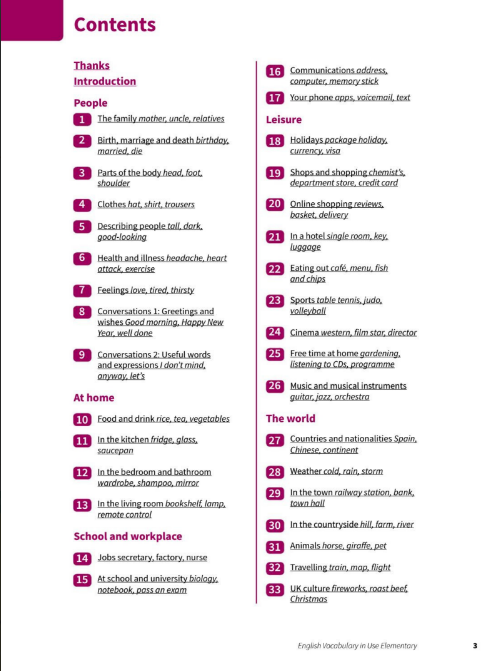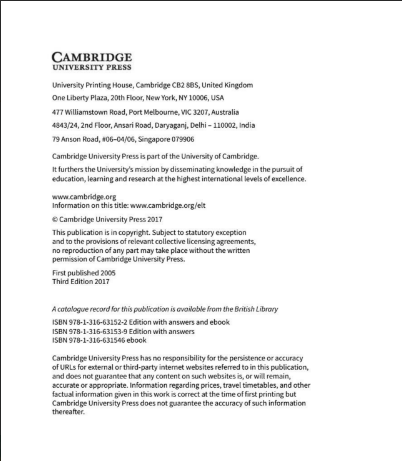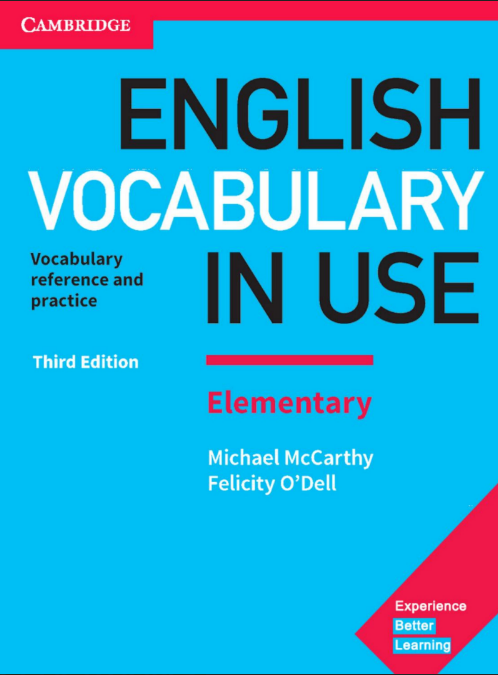


Introduction – To the student** **Introduction** **To the student** This book will help you learn around 1,250 new words and phrases. You can use the book yourself, without a teacher. You can do the units in any order you like. If you have the edition with the ebook, you can listen to the pronunciation of all the new vocabulary, and highlight text. see page 171 for more information about the ebook. Here is what the pages look like: [Diagram showing left-hand and right-hand pages with labels] **Left-hand page:** * presents the new vocabulary. * is divided into sections. * Common mistakes and learning tips are also given on the left-hand page. **Right-hand page:** * practises the new vocabulary. * Pictures, tables and diagrams give variety to the exercises. **Diagram labels:** * Diagrams and pictures show the meaning. * Example sentences show words in context. * Mini-dialogues show people use the words in real situations. * Over to you tasks give you a chance to do more work on the topic of the unit. * Type of exercise: gap-fills, answering questions, matching, etc. The Answer key at the end of the book is for you to check your answers to the exercises after you do them. The Answer key sometimes has more than one answer. This is because there is often not just one correct way of saying something. The Answer key also has possible answers for most of the exercises which are open-ended, or where you are asked to talk about yourself. The Index at the end of the book has all the important words and phrases from the left-hand pages. The Index also tells you how to pronounce words. There is a list of phonemic symbols to help you understand the pronunciation on page 158. It is a good idea to have a dictionary when you use the book so you can check the meaning of something, or translate a word into your own language. Sometimes, you will also need a dictionary for the exercises; we tell you when this is so. You also need a dictionary to notebook to write down new words. see page 170 for ideas on how to learn and remember these new words. We hope you like this book. When you have finished all the units in this book, you can go to the next book in the series, English Vocabulary in Use: Pre-intermediate and Intermediate, and after that, to the higher levels, English Vocabulary in Use: Upper-intermediate and English Vocabulary in Use: Advanced. — **Image 2: Introduction – To the teacher** **Introduction** **To the teacher** This book can be used in class or as a self-study book. It is intended for learners at A1–A2 levels of the Council of Europe scale. It aims to take learners with a very basic level of vocabulary to a point where they can use approximately 2,000 words and phrases and teaches them around 1,250 new words and phrases. The vocabulary has been chosen for its usefulness in everyday situations, and we consulted a written and spoken corpus of present-day English to help us decide on the words and phrases to be included. The new vocabulary (on average 20-30 items per unit) is presented with photos or illustrations and explanations on the left-hand page, and there are exercises and activities on the right-hand page. There is an Answer key and an index with pronunciation for all the key vocabulary. The book focuses not just on single words, but also on useful phrases and collocations. For example, difficult teaching points such as the difference between do and make are dealt with through collocation (we do our homework, but we make mistakes), and useful phrases (e.g. come along) are presented. The book is organised around everyday topics, but also has units devoted to core verbs such as get and bring / take. Typical errors are indicated where appropriate, and the most typical meanings and uses are focused on for each key item. The units in the book can be used in any order you like, but it is often a good idea to do blocks of units based round the same topic (e.g. People, At home, Leisure). The right-hand pages offer a variety of different types of activities, including traditional ones such as gap-filling, but also more open-ended ones and personalised activities which enable learners to talk about their own lives. Although the activities and exercises are designed for self-study, they can easily be adapted for pairwork, groupwork or whole-class activities in the usual ways. For example, where there are dialogues, students can take the speaking parts and practise the conversations, and where the exercises have questions and answers, students can practise asking each other the questions and answering them. See who has the best ideas for recording vocabulary in their notebook. The Answer key sometimes gives alternative answers to the exercises, and also gives possible model answers for the more personalised ones. When learners have worked through a group of units, it is a good idea to repeat some of the work (for example, the exercises) and to expand on the meaning and use of key words and phrases by extra discussion in class, and find other examples of the key items in other texts and situations. This can be done at intervals of one to three months after first working on a unit. This is important, since it is usually the case that learners need five to seven exposures to a word or phrase before they can really know it, and no single book can do enough to ensure that words are always learnt first time. When your students have finished and reviewed all the units in this book, they can move on to the next book in this series: English Vocabulary in Use: Pre-intermediate and Intermediate, by Stuart Redman. Find more resources for teachers at www.cambridge.org. We hope you enjoy using the book. — **Image 3: Exercises** **Exercises** **38.1 Fill the gaps in the sentences. Use words from A and B opposite.** 1. I always have ___________ coffee in the morning. 2. I have a ___________ every Saturday morning. My teacher is excellent. 3. Do you want to have a game of ___________? 4. Evelyn’s having a ___________ on Saturday. Are you going? 5. Do you want to have a ___________? The bathroom’s just here. 6. I have an ___________ tomorrow, so I have to study tonight. 7. We must have a ___________ to talk about these problems. 8. I’m going to the cafeteria to have a ___________ . Do you want to come? 9. The hotel has a swimming pool, so we can have a ___________ every day. 10. We can have ___________ before the film, or we can eat after it. **38.2 Correct the mistakes.** 1. Please phone Grandma when you have the moment. « 2. Scarlett has gone to the hairdresser’s to have her hair. 3. That computer game looks great. Can I have a going? 4. I have to some words with my teacher after the lesson. 5. Mum didn’t have the times to go to the shop today. 6. They don’t have got any cake in the café today. **38.3 Complete the crossword.** [Crossword grid with some handwritten answers: Across: 1. You have it in a restaurant. 3. People often have one on their birthday. 5. Do you want to have a __________ of tennis? Down: 2. You have it at school or university. 4. If you don’t like coffee, you can have ___________] **38.4 What do you say?** 1. (someone is thirsty) Why don’t you have a __________! 2. (someone is going away) Bye! Have a __________! 3. (someone sneezes (Atishoo!) and has a red nose) Oh! Have you got a __________? 4. (someone has a new camera) Is that new? Can I have a __________? **38.5 Answer the questions.** 1. Have you got any brothers or sisters? 2. What time do you have English lessons? 3. What do you have for lunch? 4. Do you have to go to lessons every day? 5. How many pens have you got with you now? 6. Do you always have a good time in your English classes? — **Image 4: Exercises (Continued)** **39.2 Write about Victoria’s New Year Resolutions.** **This year I’m going to:** * stop eating chocolate * pass my driving test * learn Spanish * watch less TV * keep my room tidy 1. This year Victoria is going to stop eating chocolate. 2. This year __________ 3. This year __________ 4. This year __________ 5. This year __________ **39.3 Look at the activities in D opposite. Which do you do on holiday? Write sentences.** I usually go shopping on holiday. **39.4 Where do trains, buses and roads go to from your town?** From Cambridge, trains go to London and to Norwich. **39.5 Are these sentences correct? If not, correct them.** 1. It’s time to go home now. X It’s time to go home now. 2. Mum is going for shopping this afternoon. 3. I’m going to London by car tomorrow. 4. I love Paris. Did you go to there last year? 5. Alexei is going to home at 4 o’clock. 6. We always go to the same café. Let’s go to somewhere different today. 7. Excuse me, please. Where does this bus go? 8. I go to swimming every Sunday morning. 9. We’re going sightseeing today. 10. Jo went down to the top of the hill. 11. Let’s go to fish today. 12. She went out off the shop. 13. Please go away. I’m tired. 14. Would you like to go to home now? **Over to you** Look in an English magazine or newspaper. Find five examples of go. Write them down in your vocabulary notebook.


